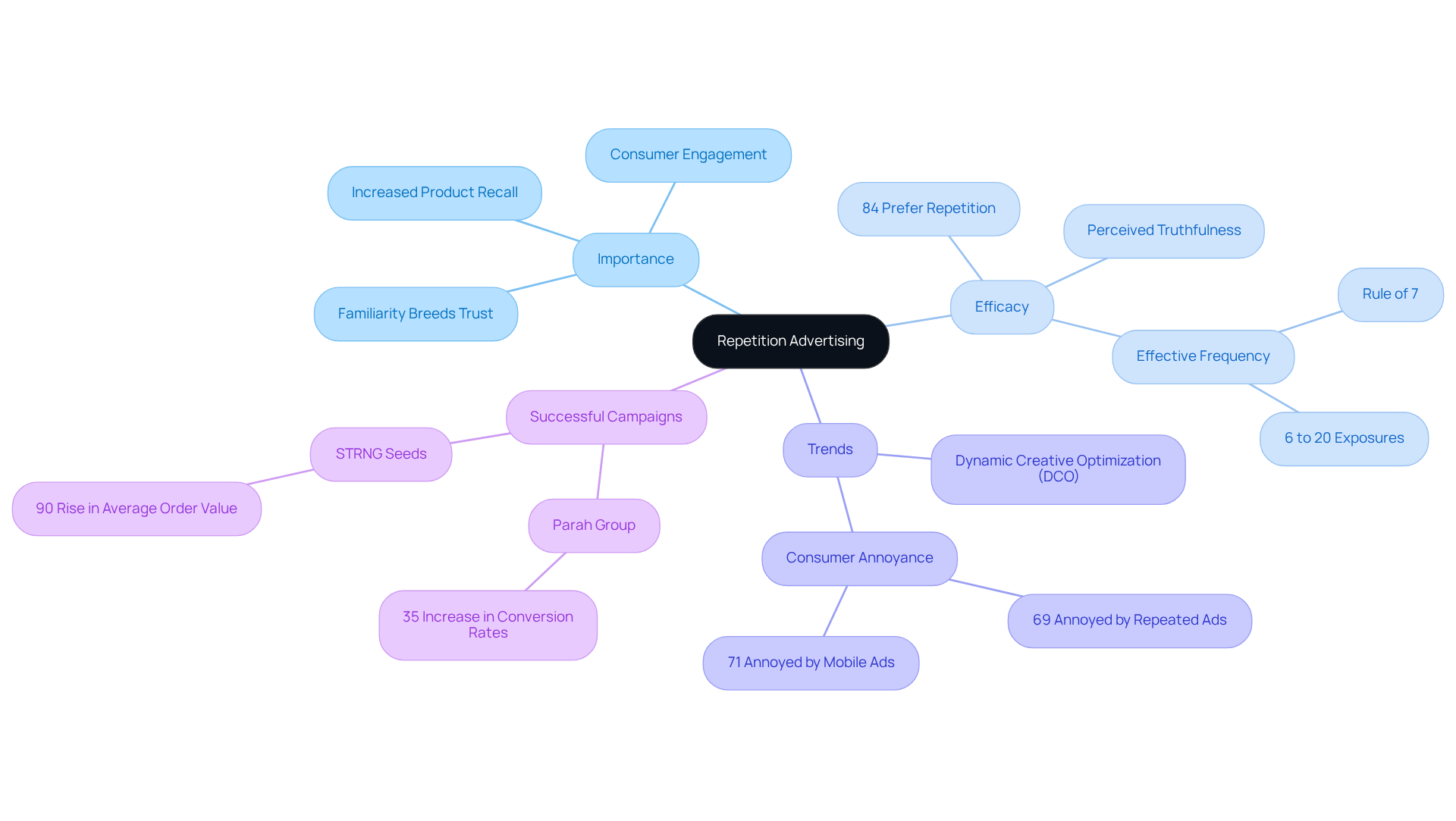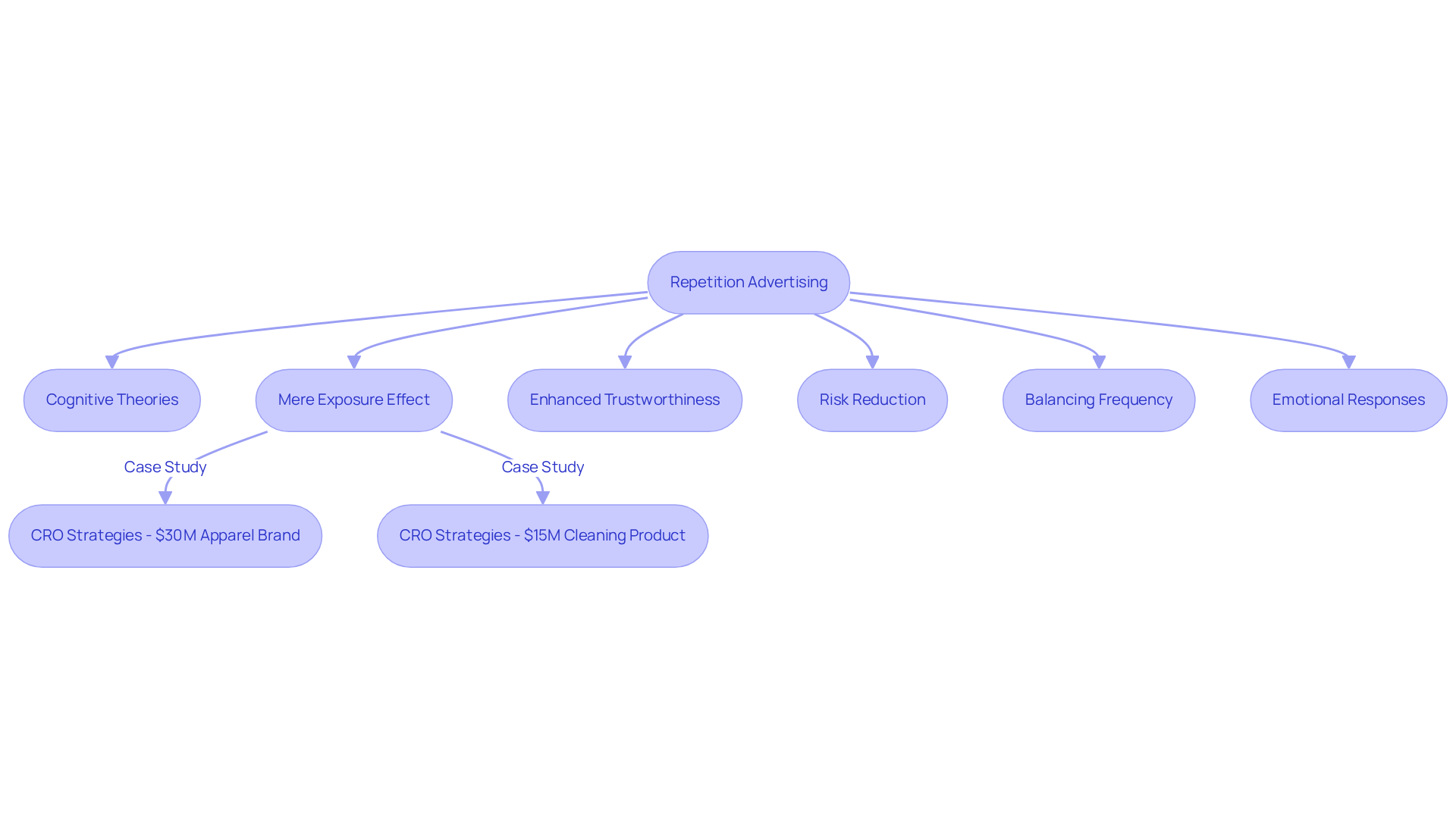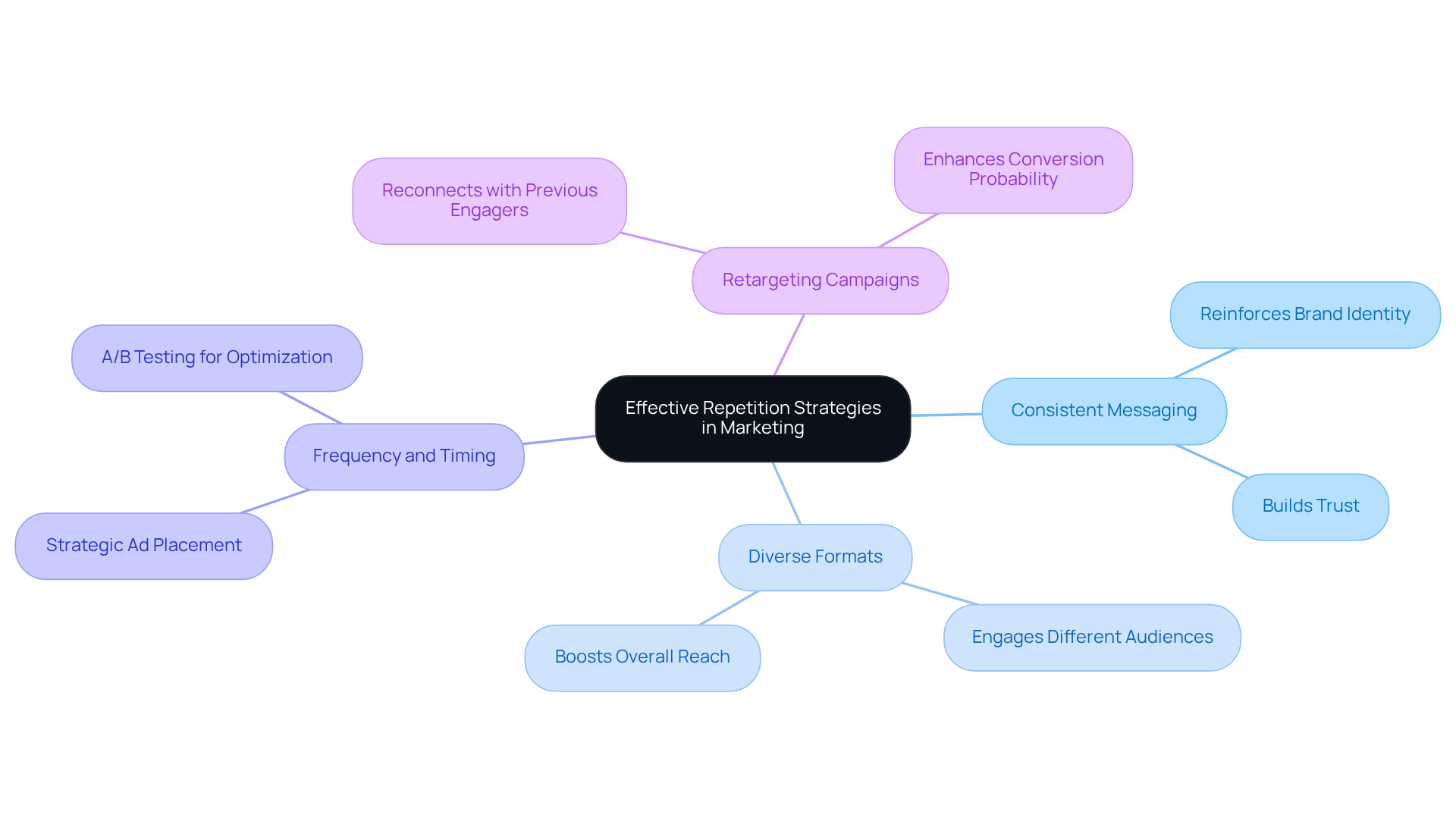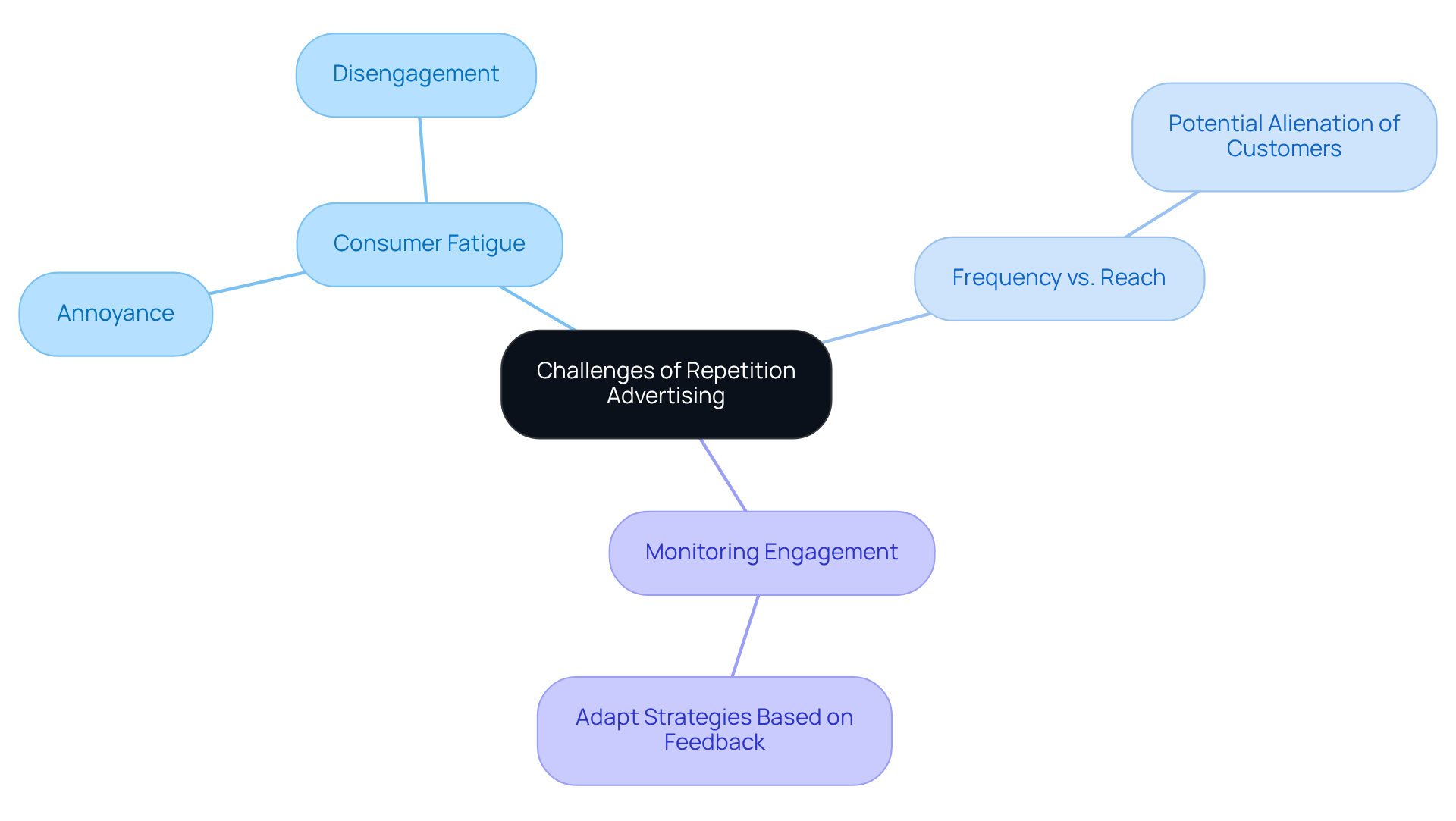
Overview
Repetition advertising stands as a pivotal marketing strategy, underscoring the necessity of consistent message exposure across diverse platforms. This approach is essential for direct-to-consumer (DTC) brands, as it significantly enhances product recall and influences purchasing decisions. By fostering familiarity and trust among consumers, repetition advertising ultimately drives increased conversion rates.
Successful case studies illustrate this principle, showcasing brands that have achieved remarkable sales improvements through strategic repetition and creative optimization. As such, embracing this method is not merely beneficial; it is imperative for brands aiming to thrive in a competitive marketplace.
Introduction
Repetition advertising has emerged as a cornerstone strategy for direct-to-consumer (DTC) brands, leveraging the power of consistent messaging to enhance consumer recall and trust. By repeatedly exposing potential customers to a brand's message across various platforms, companies can significantly increase their chances of conversion, particularly in a fiercely competitive market.
However, the challenge lies in striking the right balance—too much repetition can lead to consumer fatigue and annoyance.
How can DTC brands effectively harness the benefits of repetition advertising while avoiding its pitfalls?
Define Repetition Advertising and Its Importance
Repetition advertising serves as a pivotal marketing strategy, strategically engaging consumers through consistent exposure to a message across diverse platforms and formats. This approach is rooted in the understanding that repeated exposure cultivates familiarity, which significantly bolsters product recall and influences purchasing decisions. For direct-to-consumer (DTC) companies, where competition is intense and customer acquisition costs are escalating, repetition advertising is indispensable. It fortifies presence in the minds of potential customers, thereby increasing the likelihood of conversion when they are ready to make a purchase.
The efficacy of this strategy is underscored by the notion that familiarity breeds trust; studies reveal that repeated statements are perceived as more truthful, leading consumers to regard them as widely accepted opinions. This principle holds particular significance in today's marketplace, where 84% of respondents indicate that repetitive ads diminish their likelihood of engaging with the company. Consequently, a meticulously executed repeated advertising campaign can forge a lasting impression, amplifying the overall effectiveness of marketing initiatives and enhancing conversion rates.
Recent trends reveal that DTC companies are increasingly leveraging dynamic creative optimization (DCO) to refresh ad content and maintain consumer engagement without eliciting frustration from overexposure. Successful campaigns often employ a blend of traditional and online media, ensuring that messages resonate with a diverse audience while avoiding the pitfalls of excessive redundancy. For example, Parah Group's case studies demonstrate how a $30M apparel firm achieved a 35% increase in conversion rates through strategic homepage redesigns and gamified elements that enriched user experience. Moreover, the cannabis company STRNG Seeds saw a remarkable 90% rise in average order value by introducing free gifts and personalized landing pages, showcasing the power of targeted reinforcement in shaping buyer behavior.
It is also crucial to acknowledge that 69% of respondents express annoyance or extreme annoyance towards repeated ads on social media, underscoring the necessity for a balanced approach. Companies that have effectively harnessed repetition advertising report significant increases in recall and conversion rates, highlighting the potency of this method in influencing consumer behavior.

Explore the Psychology of Repetition in Advertising
The psychology of repetition advertising is firmly rooted in cognitive theories, particularly the mere exposure effect, which posits that individuals tend to favor familiar stimuli. This principle holds significant relevance for DTC companies, as repetition advertising through repeated exposure to messages enhances perceived trustworthiness and credibility. Familiarity diminishes the perceived risk associated with purchasing, especially for brands that consumers may not recognize well. However, it is crucial for DTC companies to strike a balance in their frequency strategies; excessive repetition can lead to consumer irritation and negative sentiments, ultimately wasting advertising resources. Moreover, repetition can elicit emotional responses, rendering companies more relatable and memorable.
For instance, Parah Group has successfully implemented CRO strategies for various DTC companies, including a $30M apparel brand that saw a remarkable 35% increase in conversion rates after optimizing their homepage to highlight social proof and customer reviews. In a similar vein, a $15M cleaning product company enhanced their average order value (AOV) by 80% through strategic bundling and pricing tests. These results underscore the profound impact of repetition advertising, particularly when paired with innovative CRO strategies, which can bolster brand identity and values, ultimately fostering customer loyalty and improving conversion rates.
To elevate promotional campaigns, DTC companies should diversify elements such as visuals and messaging, ensuring they maintain brand recognition without inducing fatigue. By strategically leveraging repetition advertising while being aware of its potential drawbacks, DTC companies can cultivate a sense of comfort and trust among consumers, thereby influencing their purchasing decisions.

Implement Effective Repetition Strategies in Marketing
To implement effective repetition advertising strategies, DTC companies must adopt several key approaches.
- Consistent Messaging is paramount; maintaining a uniform core message across all platforms—social media, email marketing, and paid ads—reinforces brand identity and builds trust among buyers.
- Next, Diverse Formats are essential. By utilizing various formats such as videos, images, and text to communicate the same message, companies can maintain engagement and cater to different audience preferences, significantly boosting overall reach.
- Furthermore, Frequency and Timing play a crucial role. Companies must strategically plan the frequency of ad placements in repetition advertising to avoid overwhelming audiences while ensuring sufficient exposure for message retention. A/B testing can be instrumental in identifying optimal exposure levels for maximum impact.
- Lastly, Retargeting Campaigns are vital for reconnecting with consumers who have previously engaged with content. This strategy reminds them of products they viewed or added to their cart, leveraging the familiarity built through practice, which substantially enhances the probability of conversion.

Identify Challenges and Risks of Repetition Advertising
While repetition advertising can be highly effective, it also presents notable challenges that must be addressed. A significant risk is consumer fatigue. When repetition advertising occurs too frequently, it can lead to annoyance and disengagement, a phenomenon known as ad fatigue. This can diminish the campaign's effectiveness and tarnish the company's reputation.
Moreover, companies must strike a careful balance between frequency and reach in their repetition advertising, as excessive exposure can alienate potential customers. To mitigate these risks, direct-to-consumer (DTC) brands should closely monitor engagement metrics and be ready to adapt their strategies based on customer feedback.
To sustain consumer interest while capitalizing on the advantages of repetition advertising, it is essential to implement a blend of creative variations and refreshing ad content periodically.

Conclusion
Repetition advertising stands as a crucial strategy for direct-to-consumer (DTC) brands, underscoring the power of consistent messaging across diverse platforms to bolster brand recall and influence purchasing decisions. This strategy not only cultivates familiarity but also establishes trust, enabling companies to differentiate themselves in a competitive landscape marked by rising customer acquisition costs.
Key insights reveal the psychological foundations of repetition, notably the mere exposure effect, which demonstrates how familiarity can shape consumer preferences. The article further delves into practical strategies for effective implementation, emphasizing the importance of:
- Maintaining consistent messaging
- Utilizing varied formats
- Managing frequency judiciously to avert consumer fatigue
Real-world examples from successful DTC campaigns highlight the tangible advantages of repetition, showcasing notable increases in conversion rates and average order values.
Ultimately, the value of repetition advertising lies in its capacity to foster a sense of comfort and trust among consumers, a critical element for driving conversions. As DTC brands navigate the intricacies of contemporary marketing, adopting a balanced approach to repetition can enhance engagement and loyalty. By leveraging the insights and strategies discussed, companies can effectively harness the power of repetition to craft impactful advertising campaigns that resonate profoundly with their target audience.
Frequently Asked Questions
What is repetition advertising?
Repetition advertising is a marketing strategy that involves consistently exposing consumers to a message across various platforms and formats, aiming to cultivate familiarity and enhance product recall, ultimately influencing purchasing decisions.
Why is repetition advertising important for direct-to-consumer (DTC) companies?
For DTC companies, repetition advertising is crucial due to intense competition and rising customer acquisition costs. It helps solidify brand presence in potential customers' minds, increasing the likelihood of conversion when they are ready to purchase.
How does familiarity from repetition advertising affect consumer behavior?
Familiarity from repetition advertising breeds trust, as repeated messages are often perceived as more truthful. This can lead consumers to view these messages as widely accepted opinions, enhancing the effectiveness of marketing efforts.
What percentage of respondents believe repetitive ads decrease engagement with a company?
84% of respondents indicate that repetitive ads diminish their likelihood of engaging with the company.
How are DTC companies adapting their repetition advertising strategies?
DTC companies are increasingly using dynamic creative optimization (DCO) to refresh ad content and maintain consumer engagement without causing frustration from overexposure. This approach combines traditional and online media to resonate with a diverse audience.
Can you provide examples of successful repetition advertising campaigns?
Yes, for instance, Parah Group's case studies show a $30M apparel firm achieved a 35% increase in conversion rates through strategic homepage redesigns and gamified elements. Additionally, STRNG Seeds, a cannabis company, saw a 90% rise in average order value by introducing free gifts and personalized landing pages.
What challenges do companies face with repetition advertising?
Companies must balance their approach, as 69% of respondents express annoyance or extreme annoyance towards repeated ads on social media. This highlights the need for careful execution to avoid excessive redundancy while still benefiting from repetition.
What benefits do companies report from effective repetition advertising?
Companies that effectively utilize repetition advertising report significant increases in both recall and conversion rates, demonstrating its effectiveness in influencing consumer behavior.
FAQs











